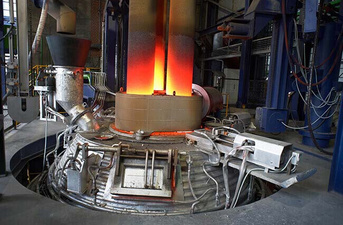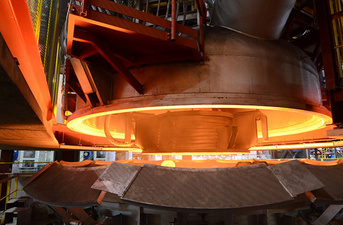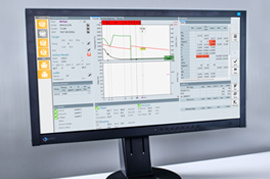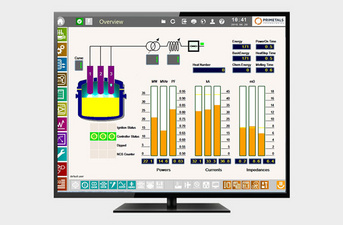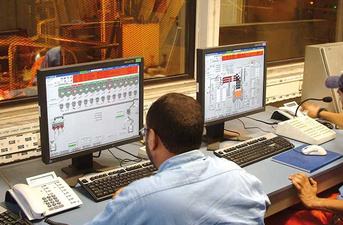SECONDARY METALLURGY — MAXIMUM EFFICIENCY, PRODUCTIVITY AND STEEL QUALITY WITH INNOVATIVE SOLUTIONS
Secondary metallurgy solutions from Primetals Technologies stands for fully integrated technology, mechanical engineering, automation and electrical engineering from a single source.
This is the basis for maximum plant availability, short charge-cycle times, low consumption values and top-quality treated steel. The result is high performance and productivity levels of both supplied and modernized plants combined with impressive cost savings in secondary metallurgy.
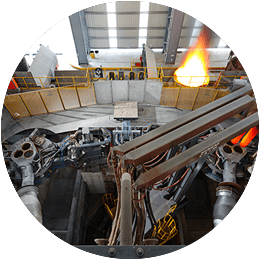
Every grade you need — Secondary Metallurgy Solutions
These technologies are the basis for maximum plant availability, short charge-cycle times, low consumption values and top-quality treated steel. The result is high performance and productivity levels of both supplied and modernized plants combined with impressive cost savings in secondary metallurgy.
From alloy handling to degassing, desulfurization and decarburization, secondary metallurgy is indispensable to the production of high-quality steel.
Our solutions in this field focus on achieving maximum efficiency and productivity through
- Finely tuned process control and automation, which ensure efficient use of personnel and additives as well as short cycle times
- Precise scaling of design parameters, which ensure verifiable conformance with consumption values
- Optimal plant design, which ensures minimal space costs for the vacuum pump, alloying facility, and metallurgical vessels
All Primetals Technologies’ components are built to withstand the highest everyday loads. We achieve this through extensive standardization, many years of teamwork with selected suppliers, certified output controls and systematic quality assurance. The result: assured delivery times, high availability and a long plant lifecycle.
Ladle furnaces (LF) – The quality link between melting and casting
Installation of a ladle furnace between the melting and casting areas is vital to assure quality and productivity improvements in steelmaking. Ladle furnace arrangements include single stations (with fixed/swiveling gantries or with ladle cars/turrets) and also twin stations (two roofs) with one swiveling electrode gantry. The compact design guarantees minimum space requirement while offering easy access to the roof and for electrode replacement.
VD/VOD plants – Vacuum Degassing for maximum metallurgical flexibility
During vacuum treatment the carbon, oxygen, nitrogen, hydrogen, and sulfur contents are reduced in different process steps depending on the melt composition. A vacuum alloy hopper system allows for compositional adjustments. Good homogenization and high alloy yields are characteristic features of this process. Depending on the metallurgical reactions in the ladle, a freeboard of 600–1,200 mm is required. In order to increase productivity, the VD (Vacuum Degassing) system can also be designed as (or extended to) a twin-vessel system. The VOD (Vacuum Oxygen Decarburization) system is a tank degassing unit which is additionally equipped with an oxygen blowing lance. This additional oxygen supply can be used for the production of extra-low carbon stainless steel grade (forced decarburization) or for chemical heating of the melt in conjunction with aluminum/silicon additions (VD-OB process (Vacuum Degassing with Oxygen Blowing)). The vacuum pump is designed accordingly, having a higher capacity in order to cope with the increased offgas volume.
RH plants – The vacuum recirculation process
The RH (Ruhrstahl Heraeus) process is carried out in a refractory-lined vessel, equipped with two snorkels which are immersed in the steel bath. By reducing the system pressure, the melt rises into the vacuum vessel where decarburization, degassing, and other degassing reactions take place. The injection of lift gas into one of the snorkels initiates a circulation process. Thereby, the whole heat is treated quickly. Immersion of the snorkels is either carried out by lowering the vacuum vessel or by lifting the ladle. In order to minimize vessel exchange time a quick-change vessel system can be provided.
VLD plants – The clever way to economical metallurgy
The VLD (Vacuum Ladle Degassing) represents the ideal solution for secondary metallurgical operations for small heat sizes ranging from 5 to 20 tons. The process was the result of a joint research and development project between Primetals Technologies and Dörrenberg Edelstahl. All process steps which are possible in VD and VOD plants can be economically carried out with the VLD plant, even the production of special and stainless steel grades. VLD plants are in operation worldwide, particularly in micromills, forging shops, and foundries.
Want to know more? Go to Lifecycle Services & Integrated Plants & Solutions
Intelligent automation for steelmaking
Meeting narrow tolerances and a fully automatic production sequence from steelmaking to casting is only possible with the support of highly sophisticated automation systems.
Depending on steel grade and quality demands, our automation systems handle all types of process variants and operational procedures for ladle treatment facilities and furnaces, as well as vacuum degassing plants (RH, VD, VOD).
Beside the elementary functionalities, such as basic automation, heat tracking and operator guidance, the Steel Expert process model package features dynamic online optimization for consistent and flexible production.
Steel Expert Prediction previews the theoretical course of the complete treatment, optimizes the scheduled treatment steps, and inserts additional actions to the treatment practice if required.
The Steel Expert Supervision model cyclically determines the actual heat status. Actual process data as well as energy input, material addition and – if applicable – vacuum degassing parameters are taken into account in order to calculate the analysis and temperature of the steel bath and slag.
For final adjustment of the steel the setpoint models calculate the required material addition and recommend the necessary measures for cooling or heating.
Further highlighted solutions:
- Melt Expert: electrode control system for ladle furnaces
- Equipment Position Monitor: automatic electronic tracking of metallurgical vessels at treatment stations
ECO Solutions for secondary metallurgy — Saving resources, creating value
Please follow the corresponding links to learn more about our competences.
Gas Cleaning
ECO Consulting
TECHNOLOGY AND MODERNIZATION PACKAGES
Get striking results with incremental investments
| Name | Short Description |
|---|
| Name | Short Description |
|---|
| Name | Short Description |
|---|
| Name | Short Description |
|---|---|
| Emission Fume Monitor | Measurement of emissions in open space for electric steelmaking |
| Bag Break Monitor | Bag break detection and localization for pulse jet bag filter-plants |
| Bag Cleaning Monitor | Acoustic monitoring of pulse jet bag filter plants |
| Equipment Position Monitor | Reliable identification and tracking of metallurgical equipment throughout the steel plant |
| Bag Filter Controller | Smart control of bag filter cleaning for dedusting plants |
| Copper-cladded roof | Copper-cladded roof for LF,VD, and VOD |
| Leakage Monitor | Leakage detection system for water cooling circuits |
| Lance Checker | Test and diagnosis system for liquid iron and steel measuring devices |
| LF / RH /VD Optimizer | Dynamic Process Optimization (Level 2) for Secondary Metallurgy (LF/RH/VD) |
| LiquiRob for Steelmaking | Robotic solution for EAF, BOF, ladle furnace, VD |
| Lomas | Gas analysis system for very hot corrosive and dust-loaded process gases |
| Melt Expert | Electrode control system for EAF and Ladle Furnace |
| RH Immersion Control | Semi-automatic, camera-guided snorkel immersion for RH plants |
| RH COB Lance | Combined oxygen and burner lance with spark plug ignition |
| VD Contact-free Temperature Measurement | Contact-free temperature measurement under vacuum for VD and VOD plants |
| Name | Short Description |
|---|
| Name | Short Description |
|---|

